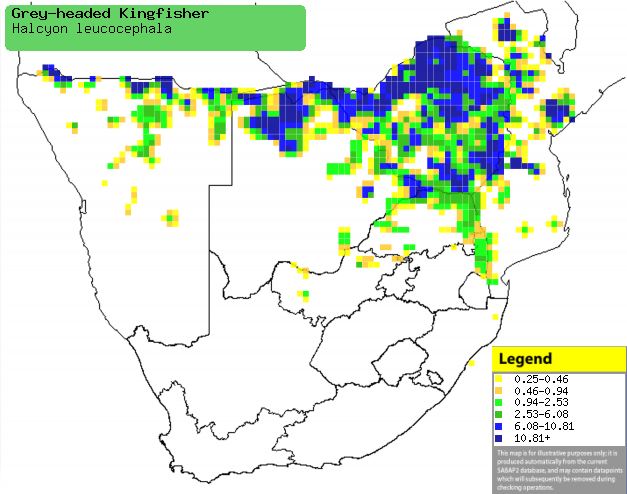|
Halcyon leucocephala (Grey-headed kingfisher,
Grey-hooded kingfisher)
Gryskopvisvanger [Afrikaans]; Muningi (generic
term for kingfisher) [Kwangali]; Tshololwana (generic term for
kingfisher) [Tsonga]; Grijskopijsvogel [Dutch]; Martin-chasseur à
tête grise [French]; Graukopfliest [German]; Pica-peixe-de-barrete-cinzento
[Portuguese]
Life
> Eukaryotes
>
Opisthokonta
> Metazoa
(animals) > Bilateria > Deuterostomia >
Chordata > Craniata > Vertebrata (vertebrates) > Gnathostomata (jawed
vertebrates) > Teleostomi (teleost fish) > Osteichthyes (bony fish) > Class:
Sarcopterygii (lobe-finned fish) > Stegocephalia (terrestrial vertebrates) >
Tetrapoda (four-legged vertebrates) > Reptiliomorpha > Amniota >
Reptilia
(reptiles) > Romeriida > Diapsida > Archosauromorpha > Archosauria >
Dinosauria (dinosaurs) > Saurischia > Theropoda (bipedal predatory
dinosaurs) > Coelurosauria > Maniraptora > Aves (birds)
> Order: Coraciiformes
> Family: Dacelonidae
The Grey-headed kingfisher is common across sub-Saharan
Africa, mainly occurring in well developed woodland, often near rivers or
streams. Its diet mainly consists of insects, especially grasshoppers,
occasionally eating small vertebrates. It is an intra-African breeding migrant,
arriving here around April and leaving in the period from December-May. Both
sexes excavate the nest, which is a burrow consisting of a tunnel leading to a
nest chamber, dug into riverbanks, gullies, etc. It lays 3-4 eggs, which are
incubated by both sexes, for about 20 days. The eggs hatch into small, naked
chicks with black bills and brownish legs, who are cared for by both parents.
Distribution and habitat
Common across sub-Saharan Africa, avoiding arid regions. In
southern Africa, it is most common in Zimbabwe and northern Botswana, but it
also has populations scattered across northern Namibia, Mozambique and Limpopo
Province. It prefers well-developed woodland often close to rivers or streams,
such as Acacia and Mopane (Colosphermum mopane) woodland.
|
 |
|
Distribution of Grey-headed kingfisher in southern Africa,
based on statistical smoothing of the records from first SA Bird Atlas
Project (©
Animal Demography unit, University of
Cape Town; smoothing by Birgit Erni and Francesca Little). Colours range
from dark blue (most common) through to yellow (least common).
See here for the latest distribution
from the SABAP2. |
Movements and migrations
Intra-African migrant, breeding in Zimbabwe,
Mozambique, Angola, Zambia, DRC and Malawi, moving north during the
non-breeding season. In southern Africa it arrives in April, goes through its
breeding cycle and then usually leaves from December-May. Note that it does not
breed in all areas of its southern African range, with most of the birds
breeding in Zimbabwe and surrounds.
Food
Its diet mainly consists of insects, especially
grasshoppers, occasionally eating small vertebrates. It usually hunts by sitting
on a perch, trying to locate prey. Once it spots something it dives to
the ground, picking up the prey item before returning to its perch. The
following food items have been recorded in its diet:
- Invertebrates
- Vertebrates (rarely)
Breeding
- Both sexes excavate the nest, which is a burrow consisting of a tunnel
leading to a nest chamber. It is usually dug into riverbanks, erosion
gullies, irrigation ditches and termite mounds.
- Egg-laying season is from September-December, peaking from
October-November.
- It lays 3-4 eggs, which are incubated by both sexes for about 20 days.
- The eggs hatch into small, naked chicks with black bills and brownish
legs, which are cared for by both parents.
Threats
Not threatened.
References
-
Hockey PAR, Dean WRJ and Ryan PG (eds) 2005. Roberts -
Birds of southern Africa, VIIth ed. The Trustees of the John Voelcker
Bird Book Fund, Cape Town.
|
